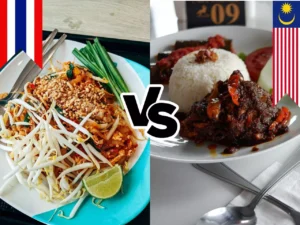Do you want to know the difference between Himalayan pink and black salt? Which is better, when, and why?
This article will compare the most often used salts in Indian cuisines: Himalayan black and pink salt. It’ll help you know when and how to use these salts in various cuisines to make the best out of them.
So, if you want to know more about them, read the article below.
Difference Between Pink Salt and Black Salt (A Quick Overview)
Himalayan pink salt and black salt differ in their preparation and taste.
Pink salt is naturally occurring, mined from the Himalayas in Pakistan (Khewra Salt Mine), and boasts a milder, slightly sweet flavor with subtle earthiness. Its pink hue comes from trace minerals like iron.
On the other hand, black salt, also known as “kala namak,” is processed Himalayan salt combined with charcoal, herbs, and seeds, giving it an umami, eggy taste. It’s reddish-brown or purple due to the heating process. Black salt is often used in South Asian cuisines and vegan cooking to mimic sulfurous egg flavor, while pink salt is favored for its nuanced taste and natural pink color.
What is Himalayan Black Salt (Kala Namak) and its Key Characteristics?

Black salt, also known as the Himalayan black salt or “kala namak,” isn’t some black salt mined from the Himalayan peak. But it’s a processed form of Himalayan salt.
Mined Himalayan salt is melted along with charcoal, herbs, bark, and seeds into a jar in a furnace for 24 hours. Later, it’s allowed to cool down. Then the salt is broken and ground to get you black salt with an umami, eggy flavor.
In South Asian cuisines, black salt is a prominent ingredient. It has traditionally been used in Ayurvedic treatments, a traditional Indian medicinal practice.
It’s apparent that black salt isn’t directly mined but prepared by adding some ingredients and melting it.
It’s also not necessarily Himalayan: Himalayan black salt means the manufacturers have used Himalayan salt to prepare black salt. Yet, most manufacturers combine activated charcoal and Mediterranean salt to prepare black salt.
Appearance
Because of the prolonged high-heating process, combining the regular rock salt with spices, herbs, and activated charcoal (or nut peels after burning) makes black salt reddish-brown or purple. It helps mix the remaining components and produces a homogeneous salt mixture.
Composition
The composition of black salt is identical to that of pink salt. It comprises sodium chloride, the primary chemical ingredient of salt, and concentrations of sulfates, iron sulfide, magnesium, potassium, and other elements found in Himalayan mountain rocks. However, the Himalayan black salt may lose many trace minerals during their extended heating process.
Taste
Black salt, also known as “kala namak,” has a unique taste often described as slightly sulfurous or eggy. It adds a hint of umami and a faint savory aroma to dishes. It’s commonly used in vegan cooking to mimic the flavor of eggs and in various Indian and Asian cuisines for its distinctive taste.
Smell
Do salts have a scent?
They don’t have any significant smell. However, the black Salt has a distinct odor.
It has a characteristic odor caused by hydrogen sulfide. Sulfur constantly has a distinct stench that is immediately detectable. However, when compared, pink salt has a little smell and doesn’t affect your recipes’ aroma.
Simply put, it’s an odorless salt that appears to be comparable to table salt. It’s what lets you use pink salt daily.
What is Pink Salt, and its Key Characteristics?

Pink salt is another form of rock salt found in the Himalayan mountains. It’s one of the naturally occurring salts. It gets its name from the pink hue of its crystals because of its higher iron ratio. The main source of Himalayan pink salt is Himalayan salt mines (Pakistan’s Punjab region).
Mass evaporation of saltwater landlocked by mountains for millions of years has formed pink salt rocks due to plate tectonic changes.
Most commonly, pink salt is used in foods. Yet, it’s also used for preservation, lamp making, baking stones, and glass preparation.
Yes, the main selling point of the pink Himalayan salt is its overstated health benefits, even though no solid scientific proof exists to back up the claims of its health benefits.
Appearance
Pink Himalayan salt, as the name implies, has hues of pink. Its color comes from trace minerals like iron oxide (rust) and magnesium. These minerals are found in the salt deposits deep within the Himalayan mountains.
When the salt is mined and processed, these minerals give it a lovely pink hue. It’s not just about taste; the color adds a touch of uniqueness to dishes, making it popular in the kitchen and as a decorative seasoning.
Composition
Pink Himalayan salt is the world’s finest salt. It primarily contains 98% sodium chloride, the same chemical as table salt. However, it gets its pink color from trace minerals like iron, potassium, and magnesium.
These minerals make it different from regular table salt. It includes up to 84 trace minerals, which are incredibly necessary and useful to our health. However, the amount needs to be bigger to benefit you significantly.
State of Existence
Pink Himalayan salt is a natural mineral mined from the Himalayan mountains in Pakistan. It exists in solid form, like regular table salt, but it’s pink because of the minerals it contains, like iron. So, in simple terms, pink Himalayan salt is just like regular salt but with a pretty pink color, and it comes from a specific region in the mountains.
Taste
Pink Himalayan salt has a milder, less intense salty taste than regular table salt. It’s often described as having a subtle, slightly sweet flavor with a hint of earthiness. Some people also say it’s less “sharp” or harsh on the palate. Its unique pink color comes from trace minerals, which can impart a delicate mineral note. It’s popular among chefs and food enthusiasts for its nuanced taste and distinctive appearance.
Smell
Pink Himalayan salt doesn’t have a strong smell. It’s mostly odorless, like regular table salt. The unique thing about it is its lovely pink color, which comes from natural minerals. You won’t notice any particular scent when you use it in cooking or sprinkle it on food. Instead, it enhances the flavor of your dishes, adding a mild, salty taste with a touch of earthiness because of its mineral content.
Pink Salt vs Black Salt: Nutritional Value Comparison
Nutritional Values of Black Salt
Salt, a condiment, adds almost no significant calories to the diet. It adds a lot of extra minerals to a dish.
The fundamental chemical formula of black salt is mostly sodium chloride (NaCl) with traces of other salts and minerals. These trace salts and minerals give black salt a distinct smell, flavor, and color. Let’s look at the chemical makeup of 100 grams of black salt.
- Sodium: 97.86 grams (1,660% Daily Value)
- Chloride: 60.3 grams
- Iron: 43.1 mg milligrams
- Sulfur: 450 milligrams
Other minerals in trace amounts include silicon, calcium, strontium, lithium, sulfur, and magnesium.
Nutritional Values of Pink Salt
Like other salts, pink salt does not add extra calories to the dish. However, it adds additional minerals that justify its use as a condiment.
Pink salt is 98% sodium chloride. The other 2% other minerals in a 100g of pink salt include:
- Sodium Chloride: 98 grams
- Potassium: 87 milligrams
- Iron: 0.0369 milligrams
- Sulfur: 450 milligrams
These minerals are found in trace concentrations and may not provide any health benefits.
Black Salt vs. Pink Salt: Which is Healthier?
None of the black or pink salt has any health advantage over others. Unlike popular beliefs (which are rooted in mere advertisements, black or pink salt doesn’t have any significant health effects. The trace mineral amount is so little that you can’t benefit from them until you eat about 100 grams of salt daily, whether pink or black and eating salt in such higher quantities may kill you instead.
Primarily, pink salt is popular for its color and milder taste, while black salt is known for its unique eggy aroma, suitable for salads and fried items.
Here are reasons why you should not pay attention to the propagated health benefits of pink or black salt.
Lack of Scientific Evidence
Many health claims associated with pink and black salt lack strong scientific evidence. They contain some minerals, but the quantities are relatively small compared to the overall mineral needs of the body.
Similar Sodium Content
Like regular table salt, pink and black salt are still primarily composed of sodium chloride. Consuming excessive amounts of salt, including these specialty salts, can contribute to high blood pressure and other health issues.
Limited Mineral Content
The mineral content in pink and black salt is minimal, and the body can obtain these minerals more efficiently from a balanced diet rich in fruits, vegetables, and other whole foods. Relying on these salts as a source of essential minerals is not advisable.
Inconsistent Quality
The quality and mineral content of pink and black salt vary widely depending on the source and processing methods. Some products may need to live up to the claims made about their health benefits.
Dietary Restrictions
People with certain dietary restrictions, such as those on low-sodium diets or with kidney problems, should use caution when consuming any salt, including specialty salts like pink and black salt.
Expense
Pink salt and black salt are often more expensive than regular table salt. If you’re using them solely for perceived health benefits that are not well-supported by scientific research, you may be spending more money without getting substantial health advantages.
Cultural Beliefs
Some health benefits of black salt, such as its digestive properties in Ayurveda, are based on cultural beliefs and may not have the same impact on everyone.
In short, pink salt and black salt can add interesting flavors and colors to your dishes; they should not be relied upon as a primary source of essential minerals or a solution to health issues. Moderation in salt consumption is key, and it’s important to base your dietary choices on a well-rounded and balanced diet supported by scientific evidence.
Pink Salt vs. Black Salt: When to Use and Why?
You can use black salt or pink salt in any dish. Their distinctive flavor makes them favorable for particular recipes. Below are the details.
Uses of Black Salt
black salt is mainly used as a flavor enhancer in many Indian and Asian cuisines. Indian “Kala Namak” is used in various foods, including raitas, salads, chutneys, fruit salads, and pickles.
Black Salt in Salads and Chaat Masala
Himalayan black salt is one of the primary elements in the funky, salty, spicy, and sour spice combination known as chaat masala.
Chaat masala gets its distinctive scent from black salt, which allows you to turn anything into chaat (a popular Indian food). Likewise, the traditional Indian salad recipes also include black salt as a flavor enhancer.
Black Salt as Umami Enhancer
Himalayan black salt is a great umami enhancer that can give depth to any recipe. You can add it to your dishes. Yet, it entirely depends on you whether you like its taste.
Black Salt in Vegan Egg-Alternative Dishes
Use black salt in vegan eggs, chickpea omelets, quiche, fried rice, tofu scramble, frittata, carbonara, or even vegan tortillas. Although black salt has less sodium than ordinary salt, a tiny quantity goes a long way toward delivering that additional unique taste.
Black Salt in Fried Recipes
Black salt may also enhance the flavors of fried meals, such as fried peanuts and fried legumes. It goes well with classic Indian spices like turmeric, coriander seeds, and mango powder.
Uses of Pink Himalayan Salt
Pink Himalayan salt can be used as an ingredient, seasoning, or cooking utensil.
As Main Ingredient
Use Himalayan salt in any recipe that asks for conventional table salts, such as soups and marinades.
Seasoning
Sprinkle Himalayan salt over popcorn for a softer flavor than table salt, or sprinkle Himalayan pink salt over a chocolate cake for a crispy texture.
Salt Block
Cook and serve steak, seafood, and other foods with a Himalayan salt block. The salt block keeps the heat in and adds flavor to recipes.
FAQs
Himalayan Pink Salt vs. Black Salt: Which is more Expensive?
Another critical distinction between these two salts is their price. Because black salt is not as widespread as pink salt or Himalayan salt, it is less expensive and more affordable, especially in India. Yet, if you want to buy it in the USA or UK, you’ll have to pay more.
Pink salt, on the other hand, is a different story. It’s a luxury item available only in a few grocery stores and online. Its propagated health benefits also contribute to its higher price tag. Therefore, it’s also more expensive and may not be as widely available.
Can you Replace Pink Salt with Black Salt?
Pink and black salt are both helpful and healthy. It is up to each person to choose which salt to use in their daily life.
When taken orally, pink salt is highly beneficial to one’s health. Several trace minerals are naturally present in it to help the body function properly.
The nutritional advantages of black salt make it a staple ingredient of Indian cuisine.
Chaats, salads, and chutneys all use black salt. A popular spice combination, Chaat masala, would not be the same without black salt.
However, you might not find the black salt flavor helpful in replacing pink salt or table salt in all your recipes. So, as table salt, using black salt is purely up to you.
Is Black Salt the Same as Himalayan salt?
Black salt is a sulfurous, pungent-smelling kiln-fired rock salt used in South Asia. It’s also named “Himalayan black salt,” “Sulemani namak,” or “Kala namak.”
Is Black Lava Salt the Same as Himalayan Black Salt?

Black lava salt isn’t the same as Himalayan black salt, which is prepared by melting rock salt with herbs and activated charcoal.
Black lava salt is believed to be salt derived from the lava of volcanoes. The most famous black lava salt is those from the volcanoes of Hawaii.
The color of true Hawaiian black lava salt is dark. It is said to be the classic form of black lava salt; nevertheless, the majority of black lava salt on the market today is regular sea salt mixed with activated charcoal.
As a result, the moniker “black lava” is more of a marketing ploy than an accurate portrayal of reality. The sea salt may or may not have originated in Hawaii.
Why Does Black Salt Taste Like an Egg?
The primary flavor of black salt is umami-like. Because of its high sulfur concentration, it has a distinctive odor similar to a hard-boiled egg. Some users also report it smells like rotten eggs.
Why is Black Salt Better Than Common Salt?
Yes, black salt is better than table salt for the following reasons:
- Table salt is pure sodium chloride. It doesn’t provide any additional minerals. However, in addition to sodium chloride, black salt contains trace minerals.
- Black salt contains trace quantities of minerals like sodium (Na), iron (Fe), calcium (Ca), potassium (K), strontium (Sr), magnesium (Mg), silicon (Si), chlorine (Cl), lithium (Li), and sulfur (S). All of these minerals have unique purposes in our bodies.
- The sodium level of black salt is lower than that of ordinary salt. Common salt (sodium chloride) has a sodium level of 390 mg sodium/g, whereas black salt has a sodium content of 378.3 mg sodium/g.
Final Thoughts
Black and pink salts have subtle differences in their uses, taste, and appearance; they have their place in a routine diet. You can choose any depending on your recipe needs. Yet, ignore them for health benefits–they’re little.








